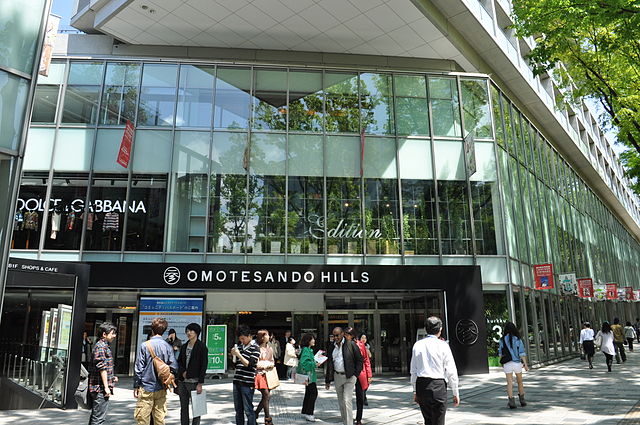I wrote about Meiji Shrine in my last article, so taking on its surrounding neighbourhood would be a natural progression, that neighbourhood being Harajuku (原宿). Harajuku is home to the aforementioned Meiji Shrine, the adjacent Yoyogi Park, and fashion. Lots and lots of fashion outlets, mainly centered around two separate streets, both of which I'll be covering as we go along. But even if fashion alone holds little interest for you, Harajuku may just offer something for everyone.
For my walk, I started from the Meiji-jingu-mae subway station. It drops you off in the middle of Omote-sando, a boulevard running about a kilometer (3,280 feet), east to west. The name "Omote-sando" (表参道) means "front approach", namely, the approach to the front of Meiji Shrine. The density of high-end fashion retail situated on Omote-sando has earned it comparisons to Champs-Elysee in Paris, or 5th Avenue in New York.
Also, "this is big billboard". Missing particle aside, it speaks the truth.
Tokyu Plaza is a shopping mall on the eastern corner of the above intersection. In addition to anchor stores like American Eagle and Tommy Hilfiger, it boasts a pleasant rooftop garden.
Even if you don't much care for the kind of fashion for sale on Omotesando (or simply don't have the money for it), it's still worth walking up and down the boulevard to see the unique architecture on display. The Tokyu Plaza mall I showed above is one example, and this Gold's Gym is another.
 |
| Ocdp [CC0], from Wikimedia Commons |
 |
| Syced [GFDL or CC BY-SA 3.0], from Wikimedia Commons |
Back on the other end of Omote-sando, near JR's Harajuku Station, is the Yoyogi National Gymnasium. The stadium was designed by Kenzo Tange. It opened for the 1964 Summer Olympics, when it hosted swimming and diving events. In the 2020 Olympics, it will be re-used for handball. It is also featured in the background of the anime film The Boy and the Beast, during the climactic scenes.
This gate marks the entrance to Takeshita Street (竹下通り, Takeshita-dōri, lit. 'beneath-bamboo road'). Takeshita-dori runs parallel to Omote-sando, but is shorter, more tightly-packed, and has a more youthful focus.
The same entrance, from the other side.
I trust this shot will get across the volume of foot traffic on Takeshita-dori that day.
Harajuku is famous for its crepes. Two crepe stands compete for attention at this intersection: Angel's Heart on the left, and Marion Crepes on the right. I got one from the latter.
Over the years, Harajuku has become a hotspot of fashion, as exemplified by this costume shop.
More costumes. The one on the right, if I have it correctly, is virtual idol Miku Hatsune's "Senbonzakura" outfit, based on the music video for the song of the same name. Here it is, embedded below.
It took some searching, but just off of Takeshita-dori I found this store devoted to the Evangelion anime franchise. Sadly this appears to have been a temporary affair; the store has shifted focus to other anime since then, including Uta no Prince-sama, Love Live, and Haikyuu!!, and may have launched a new theme by the time you read this. Still, I'm a bigger fan of Eva than any of those other things, so lucky me! Don't believe me when I call myself an Eva fan (an appellation this trip only served to bolster)? If you want to read my further thoughts on Eva, I wrote reviews of the original series, and the movie End of Evangelion, on my other blog.
Fun Fact: The "Tokyo-01" designation is an in-joke. It refers to Tokyo-03, where much of the Evangelion universe's stories are set. Tokyo-03 is an underground city (near real-world Hakone) built after the original Tokyo, and presumably other cities, were destroyed in a global disaster.
The main characters of the Evangelion universe, in present-day fashions. From left to right: Kaworu Nagisa, Rei Ayanami, Shinji Ikari, Asuka Langley Shikinami, and Mari Illustrious Makinami.
Even the vending machine in back of the store is Eva-themed. It features artwork of Rei (front), Asuka (right), and Mari (left, not visible) in their plugsuits.
Among other things, I scored a box of chocolate-filled ningyo-yaki from the Evangelion Store. They depict the heads of some of the Evas (giant robots), Angels (giant monsters), and the logo of the NERV agency.
Edit 2 November 2016: It appears the Evangelion Store hasn't gone away completely, but has instead moved to Ikebukuro. Its new location is on the 2nd floor of the P' Parco shopping mall, just a couple of minutes on foot north from Ikebukuro Station. More information: (Japanese) (Google Maps)
Access: The closest stations are Harajuku Station (JR Yamanote (JY) line) and Meiji Jingu-mae Station (Tokyo Metro Chiyoda (C) and Fukutoshin (F) lines). Omote-sando Station (Tokyo Metro Ginza (G), Chiyoda, and Hanzomon (H) lines) is also nearby, on the east end of Omote-sando.
From Shinjuku Station, take the Yamanote line to Harajuku (5 minutes, ¥140). From Tokyo Station, walk to the nearby Nijubashi-mae Station and take the Chiyoda subway line to Meiji Jingu-mae (13 minutes, ¥200).
Tokyu Plaza Omotesando Harajuku
Hours: 8:00 AM to 11:30 PM; varies by store.
Address: 4-30-3 Jingu-mae, Shibuya-ku, Tōkyō-to 〒150-0001
Website: (English) (Japanese)
Omotesando Hills
Hours: 11:00 AM to 9:00 PM; varies by store.
Address: 4-12-12 Jingu-mae, Shibuya-ku, Tōkyō-to 〒150-0001
Website: (English) (Japanese)
Oriental Bazaar
Hours: 10:00 AM to 7:00 PM.
Address: 5-9-13 Jingu-mae, Shibuya-ku, Tōkyō-to 〒150-0001
Website: (English) (Japanese)
Kiddy Land
Hours: 11:00 AM to 9:00 PM; opens 10:30 AM on weekends.
Address: 6-1-9 Jingu-mae, Shibuya-ku, Tōkyō-to 〒150-0001
Website: (English) (Japanese)















